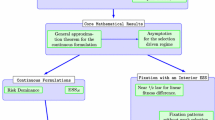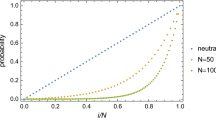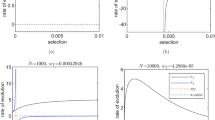Abstract
We study stochastic evolutionary game dynamics in a population of finite size. Individuals in the population are divided into two dynamically evolving groups. The structure of the population is formally described by a Wright–Fisher type Markov chain with a frequency dependent fitness. In a strong selection regime that favors one of the two groups, we obtain qualitatively matching lower and upper bounds for the fixation probability of the advantageous population. In the infinite population limit we obtain an exact result showing that a single advantageous mutant can invade an infinite population with a positive probability. We also give asymptotically sharp bounds for the fixation time distribution.


Similar content being viewed by others
References
Adlam B, Nowak MA (2014) Universality of fixation probabilities in randomly structured populations. Sci Rep 4, article 6692
Agresti A (1974) Bounds on the extinction time distribution of a branching process. Adv Appl Probab 6:322–335
Allen B, Tarnita CE (2014) Measures of success in a class of evolutionary models with fixed population size and structure. J Math Biol 68:109–143
Antal T, Scheuring T (2006) Fixation of strategies for an evolutionary game in finite populations. Bull Math Biol 68:1923–1944
Arnold BC (1968) A modification of a result due to Moran. J Appl Probab 5:220–223
Barbour AD, Holst L, Janson S (1992) Poisson approximation (oxford studies in probability, vol 2). Oxford University Press, New York
Billingsley P (1999) Convergence of probability measures (Wiley series in probability and statistics). Wiley, New York
Buckley MJ, Seneta E (1983) On Arnold’s treatment of Moran’s bounds. Adv Appl Probab 15:212–213
Buckley FM, Pollett PK (2010) Limit theorems for discrete-time metapopulation models. Probab Surv 7:53–83
Chalub FACC, Souza MO (2014) The frequency-dependent Wright–Fisher model: diffusive and non-diffusive approximations. J Math Biol 68:1089–1133
Chatterjee S, Diaconis P, Meckes E (2005) Exchangeable pairs and Poisson approximation. Probab Surv 2:64–106
Cox JT, Durrett R (2016) Evolutionary games on the torus with weak selection. Stoch Process Appl 126:2388–2409
Daley DJ (1968) Stochastically monotone Markov chains. Z Wahrsch Verw Gebiete 10:305–317
Daley DJ, Moran PAP (1968) Two-sided inequalities for waiting time and queue size distributions in \(GI/G/1\). Theory Probab Appl 13:338–341
Dixit AK, Nalebuff BJ (1991) Thinking strategically: the competitive edge in business, politics, and everyday life. W. W. Norton & Company, New York
Durrett R (2010a) Probability: theory and examples, 4th ed., Cambridge series in statistical and probabilistic mathematics. Cambridge University Press, Cambridge
Durrett R (2010b) Probability models for DNA sequence evolution, 2nd ed., Springer series in probability and its applications. Springer, New York
Durrett R (2016) Spatial evolutionary games with small selection coefficients. Electron J Probab 19, paper 121
Etheridge A (2011) Some mathematical models from population genetics. In: Lectures from the 39th probability summer school held in saint-flour, 2009. Lecture notes in mathematics, 2012. Springer, Heidelberg
Evilsizor S, Lanchier N (2016) Evolutionary games on the lattice: death-birth updating process. Electron J Probab 21, paper 17
Ewens WJ (2004) Mathematical population genetics I. Theoretical introduction. Springer sereis in interdisciplinary applied mathematics, vol 27. Springer, New York
Fisher RA (1930) The genetical theory of natural selection. Clarendon, Oxford
Foxall E, Lanchier N (2016) Evolutionary games on the lattice: death and birth of the fittest. Preprint is available electronically at arXiv:1605.04037
Fudenberg D, Nowak MA, Taylor C, Imhof LA (2006) Evolutionary game dynamics in finite populations with strong selection and weak mutation. Theor Popul Biol 70:352–363
Gale JS (1990) Theoretical population genetics. Hunwin Hyman, London
Haldane JBS (1927) A mathematical theory of natural and artificial selection, Part V: selection and mutation. Proc Camb Philos Soc 23:838–844
Hoeffding W (1963) Probability inequalities for sums of bounded random variables. J Am Stat Assoc 58:13–30
Hofbauer J, Sigmund K (1998) Evolutionary games and population dynamics. Cambridge University Press, Cambridge
Imhof LA, Nowak MA (2006) Evolutionary game dynamics in a Wright–Fisher process. J Math Biol 52:667–681
Karlin A, Peres Y (2014) Game theory, alive. Draft is available at http://homes.cs.washington.edu/~karlin/GameTheoryBook.pdf
Karr AF (1975) Weak convergence of a sequence of Markov chains. Z Wahrsch Verw Gebiete 33:41–48
Kamae T, Krengel V, O’Brien GL (1977) Stochastic inequalities on partially ordered spaces. Ann Probab 5:899–912
Lawler G (2006) Introduction to stochastic processes, 2nd edn. Chapman & Hall, London
Lessard S, Ladret V (2007) The probability of fixation of a single mutant in an exchangeable selection model. J Math Biol 54:721–744
Maynard Smith J (1982) Evolution and the theory of games. Cambridge University Press, Cambridge
McCandlish DM, Epstein CL, Plotkin JB (2015) Formal properties of the probability of fixation: identities, inequalities and approximations. Theor Popul Biol 99:98–113
McCandlish DM, Stoltzfus A (2014) Modeling evolution using the probability of fixation: history and implications. Q Rev Biol 89:225–252
Moran PAP (1960) The survival of a mutant gene under selection. II. J Aust Math Soc 1:485–491
Moran PAP (1961) The survival of a mutant under general conditions. Math Proc Camb Philos Soc 57:304–314
Nowak MA (2006) Evolutionary Dynamics: exploring the equations of life. Harvard University Press, Cambridge
Nowak MA, Sasaki A, Taylor C, Fudenberg D (2004) Emergence of cooperation and evolutionary stability in finite populations. Nature 428:646–650
Nowak MA, Tarnita CE, Antal T (2010) Evolutionary dynamics in structured populations. Philos Trans R Soc B 365:19–30
O’Brien GL (1975) The comparison method for stochastic processes. Ann Probab 3:80–88
Patwa Z, Wahl LM (2008) The fixation probability of beneficial mutations. J R Soc Interface 5:1279–1289
Rannala B (1997) On the genealogy of a rare allele. Theor Popul Biol 52:216–223
Sandholm WH (2010) Population games and evolutionary dynamics (economic learning and social evolution). MIT Press, Cambridge
Sonderman D (1980) Comparing semi-Markov processes. Math Oper Res 5:110–119
Taylor C, Fudenberg D, Sasaki A, Nowak MA (2004) Evolutionary game dynamics in finite populations. Bull Math Biol 66:1621–1644
Traulsen A, Hauert C (2009) Stochastic evolutionary game dynamics. In: Schuster HG (ed) Reviews of nonlinear dynamics and complexity, vol II. Wiley, Weinheim, pp 25–61
Traulsen A, Hauert C, De Silva H, Nowak MA, Sigmund K (2009) Exploration dynamics in evolutionary games. Proc Natl Acad Sci USA 106:709–712
Traulsen A, Semmann D, Sommerfeld RD, Krambeck H-J, Milinski M (2010) Human strategy updating in evolutionary games. Proc Natl Acad Sci USA 107:2962–2966
Waxman D (2011) Comparison and content of the Wright–Fisher model of random genetic drift, the diffusion approximation, and an intermediate model. J Theor Biol 269:79–87
Weibull JW (1997) Evolutionary game theory. MIT Press, Cambridge
Acknowledgements
The work of T.C. was partially supported by the Alliance for Diversity in Mathematical Sciences Postdoctoral Fellowship. O. A. thanks the Department of Mathematics at Iowa State University for its hospitality during a visit in which part of this work was carried out. A.M. would like to thank the Computational Science and Engineering Laboratory at ETH Zürich for the warm hospitality during a sabbatical semester. The research of A.M. is supported in part by the National Science Foundation under Grants NSF CDS&E-MSS 1521266 and NSF CAREER 1552903.
Author information
Authors and Affiliations
Corresponding author
Appendices
Appendix 1: Moran process
The goal of this section is to obtain an analogue of Theorem 3 (i. e., of the results stated in full detail in Theorems 4 and 6) for the frequency-dependent Moran process introduced in Nowak et al. (2004), Taylor et al. (2004). The main result of this section is stated in Theorem 8.
For a given integer \(N\ge 2,\) the Moran process which we denote by \(Y^{(N)}_t,\) \(t\in {\mathbb Z}_+,\) is a discrete-time birth and death Markov chain on \({\varOmega }_{_N}\) with transition kernel \(P^{(N)}_{i,j}:=P\bigl (Y^{(N)}_{t+1}=j\bigl |Y^{(N)}_t=i\bigr )\) defined as follows. The chain has two absorbtion states, 0 and N, and for any \(i\in {\varOmega }_{_N}^o,\)
The process in this form, with a general selection parameter \(w\in (0,1],\) was introduced in Nowak et al. (2004). We remark that even though (Taylor et al. 2004) formally considered only the basic variant with \(w=1,\) their main theorems hold for an arbitrary \(w\in (0,1].\)
Similarly to (3), we define
where \(\tau =\inf \bigl \{t>0:Y^{(N)}_t=0~\text{ or }~Y^{(N)}_t=N\bigr \}.\) Since the Moran model is a birth-death process, the fixation probabilities are known explicitly (Nowak et al. 2004; Taylor et al. 2004) [see, for instance, Example 6.4.4 in Durrett (2010a) for a general birth and death chain result]:
In what follows we however bypass a direct use of this formula.
The result following is an analogue of Lemma 1 for the Moran process.
Lemma 6
Let Assumption 2 hold. Then for any \(N\ge N_0\) and \(i\in {\varOmega }_{_N}^o,\)
Proof
We will only prove the first inequality in (44). The proof of the second one can be carried out in a similar manner. We have:
Since by virtue of (2) and Assumption 2,
we conclude that \(E\bigl (\gamma ^{Y^{(N)}_{t+1}}\bigl |Y^{(N)}_t=i\bigr )\le \gamma ^i\). \(\square \)
In the same way as Lemma 1 implies Theorem 4, the above result yields the following bounds for the fixation probabilities in the Moran process:
More precisely, we have:
Theorem 8
Let Assumption 1 hold. Then:
-
(i)
For any \(N\ge N_0\) and \(i\in {\varOmega }_{_N}^o,\) the inequalities in (45) hold true.
-
(ii)
Furthermore, for any \(i\in {\mathbb N},\)
$$\begin{aligned} \lim _{N \rightarrow \infty } \widehat{p}_{_N}(i)=1-\lambda ^{-i}, \end{aligned}$$(46)where \(\lambda \) is defined in (19).
A proof of the limit in (46) is outlined at the end of the appendix, after the following Remark.
Remark 4
The identities for the optimal values of \(\alpha \) and \(\gamma \) given in (7) suggest that in some cases one of the bounds in (45) might be asymptotically tight for large populations. The purpose of this remark is to explore conditions for the equalities \(\lambda ^{-1}=\alpha \) or \(\lambda ^{-1}=\gamma \) to hold true. By the definition given in (19), \(\lambda =\lim _{N\rightarrow \infty } \frac{f_{_N}(i)}{g_{_N}(i)}\) for any \(i\in {\mathbb N}.\) Moreover, for any \(N\ge N_0,\)
and
It follows from (47) that
Furthermore, (48) implies that
and
In principle, the last three identities contain all the information which is needed to identify necessary and sufficient conditions for the occurrence of either \(\alpha =\lambda ^{-1}\) or \(\gamma =\lambda ^{-1},\) where it is assumed, as in (7), that the optimal bounds \(\alpha =\inf _{N\ge N_0}\min _{i\in {\varOmega }^o_{_N}} \frac{g_{_N}(i)}{f_{_N}(i)}\) and \(\gamma =\sup _{N\ge N_0}\max _{i\in {\varOmega }^o_{_N}} \frac{g_{_N}(i)}{f_{_N}(i)}\) are employed. For instance, in the generic prisoner’s dilemma case \(b>d>a>c\) one can set
provided that \(\frac{\displaystyle 1-w+wb}{\displaystyle 1-w+wd } \le \frac{\displaystyle 1-w+wa}{\displaystyle 1-w+wc },\) which is equivalent to
This leads us to consider the following possible scenarios for a prisoner’s-dilemma-type underlying game, that is assuming that \(b>d>a>c:\)
-
1.
\(ad\ge bc\) and \(c+b-a-d\le 0\) (for instance, \(b=4,d=3,a=2,c=1\)). In this case (49) holds for any \(w\in (0,1].\)
-
2.
\(ad>bc\) and \(c+b-a-d> 0\) (for instance, \(b=5,d=3,a=2,c=1\)). In this case (49) holds if and only if
$$\begin{aligned} \frac{1-w}{w}\le \frac{ad-bc}{c+b-a-d} \quad \Leftrightarrow \quad w\ge \Bigl (1+\frac{ad-bc}{c+b-a-d}\Bigr )^{-1}. \end{aligned}$$ -
3.
\(ad=bc\) and \(c+b-a-d> 0\) (for instance, \(b=6,d=3,a=2,c=1\)). In this case (49) holds only if \(w=1.\)
-
4.
\(ad<bc\) and \(c+b-a-d\ge 0\) (for instance, \(b=7,d=3,a=2,c=1\)). In this case (49) holds for no \(w\in (0,1].\)
-
5.
It remains to consider the case when \(ad<bc\) and \(c+b-a-d< 0.\) We will now verify that this actually cannot happen. To get a contradiction, assume that this scenario is feasible and let \(\varepsilon =\min \{b-d,a-c\},\) \(d'=d+\varepsilon ,\) \(c'=c+\varepsilon .\) Then
$$\begin{aligned} c'+b-a-d'=c+b-a-d< 0 \end{aligned}$$(50)and, since \(ad<bc\) and \(a<b,\)
$$\begin{aligned} ad'=ad+a\varepsilon <bc'=bc+b\varepsilon . \end{aligned}$$(51)But, due to the choice of \(\varepsilon \) we made, we should have either \(b=d'\) or \(a=c'.\) In the former case (50) and (51) imply the combination of inequalities \(c'-a< 0\) and \(a<c',\) while in the latter they yield \(b-d'< 0\) and \(d'<b,\) neither of which is possible.
The limit in (46) has been computed in Antal and Scheuring (2006) (technically, in the specific case \(w=1\)), see in particular formula (39) there. The proof in Antal and Scheuring (2006) relies on (43) and involves some semi-formal approximation arguments. We conclude this appendix with the outline of a formal proof of this result which is based on a different approach, similar to the one employed in the proof of Theorem 6.
Toward this end observe first that, provided that both processes have the same initial state, the fixation probabilities of the Markov chain \(Y^{(N)}\) coincide with those of a Markov chain \({\widetilde{Y}}^{(N)}=\bigl ({\widetilde{Y}}^{(N)}_t\bigr )_{t\in {\mathbb Z}_+}\) on the state space \({\varOmega }_{_N}\) with transition kernel \({\widetilde{P}}^{(N)}_{i,j}:=P\bigl ({\widetilde{Y}}^{(N)}_{t+1}=j\bigl |{\widetilde{Y}}^{(N)}_t=i\bigr )\) which is defined as follows. Similarly to \(Y^{(N)},\) the chain \({\widetilde{Y}}^{(N)}\) has two absorbtion states, 0 and N. Furthermore, for any \(i\in {\varOmega }_{_N}^o,\)
The advantage of using the chain \({\widetilde{Y}}^{(N)}\) over \(Y^{(N)}\) rests on the fact that while both \(P^{(N)}_{i,i-1}\) and \(P^{(N)}_{i,i+1}\) converge to zero as \(N\rightarrow \infty ,\)
and, consequently, \(\lim _{N\rightarrow \infty } {\widetilde{P}}^{(N)}_{i,i-1}=\frac{1}{1+\lambda }.\) In other words, as \(N\rightarrow \infty ,\) the sequence of Markov chains \({\widetilde{Y}}^{(N)}\) converges weakly to the nearest-neighbor random walk (birth and death chain) \(\widetilde{Z}=\bigl (\widetilde{Z}_t\bigr )_{t\in {\mathbb Z}_+}\) on \({\mathbb Z}_+\) with absorbtion state at zero and transition kernel defined at \(i\in {\mathbb N}\) as follows:
If \(\lambda >1,\) then, similarly to (28), we have \(P\bigl (\lim _{t\rightarrow \infty } \widetilde{Z}_t=+\infty \bigr )>0.\) The rest of the proof is similar to the argument following (28) in the proof of Theorem 6, with the processes \({\widetilde{Y}}^{(N)}\) and \(\widetilde{Z}\) considered instead of, respectively, \(X^{(N)}\) and Z. The only two exceptions are:
-
1.
\(P\bigl (\lim _{t\rightarrow \infty } \widetilde{Z}_t=0\bigl |\widetilde{Z}_t=i\bigr )=\lambda ^i\) for any \(i\in {\mathbb N}.\) This follows from the solution to the “infinite-horizon” variation of the standard gambler’s ruin problem (Durrett 2010a) (take the limit as \(N\rightarrow \infty \) in (43) assuming that \(\frac{g_{_N}(k)}{f_{_N}(k)}=\lambda ^{-1}\) for all \(N,k\in {\mathbb N}\)).
-
2.
The last four lines in (33) should be suitably replaced. For instance, one can use the following bound:
$$\begin{aligned}&P\Bigl ({\widetilde{Y}}^{(N)}_1\ne 0,\ldots , {\widetilde{Y}}^{(N)}_{K-1}\ne 0,\,\max _{0\le t \le K-1}{\widetilde{Y}}^{(N)}_t<m\Bigr ) \\&\qquad +\sum _{j=m}^{N-1} P\Bigl (\max _{0\le t \le K-1}{\widetilde{Y}}^{(N)}_t=j\Bigr )\cdot \bigl (1-\widehat{p}_{_N}(j)\bigr ) \\&\quad \le \Bigl [1-P\bigl ({\widetilde{Y}}^{(N)}_1=m-2,{\widetilde{Y}}^{(N)}_2=m-3,\ldots , {\widetilde{Y}}^{(N)}_{m-1}=0\bigl |{\widetilde{Y}}^{(N)}_0=m-1\bigr )\Bigr ]^{\frac{K}{m-1}} \\&\qquad + \bigl (1-\widehat{p}_{_N}(m)\bigr ) \\&\quad \le \Bigl [1-\prod _{i=1}^{m-1}\frac{P^{(N)}_{i,i-1}}{P^{(N)}_{i,i-1}+P^{(N)}_{i,i+1}}\Bigr ]^{\frac{K}{m-1}}+\frac{\gamma ^m}{1-\gamma ^N} \\&\quad =\Bigl [1-\prod _{i=1}^{m-1}\frac{g_{_N}(i)}{g_{_N}(i)+f_{_N}(i)}\Bigr ]^{\frac{K}{m-1}}+\frac{\gamma ^m}{1-\gamma ^N} \\&\quad \le \Bigl [1-\Bigl (\frac{\alpha }{1+\alpha }\Bigr )^{m-1}\Bigr ]^{\frac{K}{m-1}}+\frac{\gamma ^m}{1-\gamma ^N}. \end{aligned}$$
We leave the details to the reader.
Appendix 2
In this short appendix we discuss an interpretation of the drift \(\mu _{_N}(i)\) which is not used anywhere the paper, but it is worthwhile to state it explicitly as it is of independent interest. For \(i\in {\varOmega }_{_N}\) and \(j=1,\ldots ,N,\) let
Thus, if one enumerates and labels the individuals at the state \(X^{(N)}_t=i\) in such a way that the first i individuals are of type A and get labeled 1, and the remaining \(N-i\) individuals are of type B and get labeled 0, then \(S_{N,i}(j)\) and \(F_{N,i}(j)\) represent, respectively, the label and the fitness of the j-th individual. Furthermore, using the above enumeration, let (u, v), \(u<v,\) be a pair of individuals chosen at random. That is,
Let
be the heterozygosity (Durrett 2010b, Section 1.2) of the Wright–Fisher process \(X^{(N)}\) at state \(i\in {\varOmega }_{_N}^o,\) that is the probability that two individuals randomly chosen from the population when \(X^{(N)}_t=i\) have different types. In this notation,
suggesting that the drift \(\mu _{_N}(i)\) can serve as a measure of heterozygosity that is suitable for our game-theoretic framework.
Rights and permissions
About this article
Cite this article
Chumley, T., Aydogmus, O., Matzavinos, A. et al. Moran-type bounds for the fixation probability in a frequency-dependent Wright–Fisher model. J. Math. Biol. 76, 1–35 (2018). https://doi.org/10.1007/s00285-017-1137-2
Received:
Revised:
Published:
Issue Date:
DOI: https://doi.org/10.1007/s00285-017-1137-2




